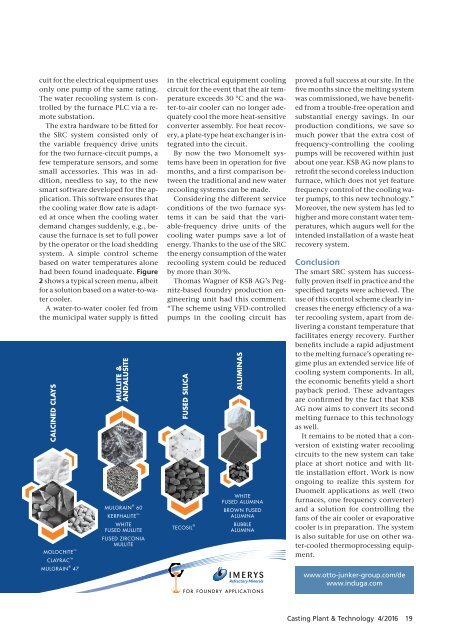CPT International 04/2016
The leading technical journal for the global foundry industry – Das führende Fachmagazin für die weltweite Gießerei-Industrie
The leading technical journal for the
global foundry industry – Das führende Fachmagazin für die
weltweite Gießerei-Industrie
You also want an ePaper? Increase the reach of your titles
YUMPU automatically turns print PDFs into web optimized ePapers that Google loves.
cuit for the electrical equipment uses<br />
only one pump of the same rating.<br />
The water recooling system is controlled<br />
by the furnace PLC via a remote<br />
substation.<br />
The extra hardware to be fitted for<br />
the SRC system consisted only of<br />
the variable frequency drive units<br />
for the two furnace-circuit pumps, a<br />
few temperature sensors, and some<br />
small accessories. This was in addition,<br />
needless to say, to the new<br />
smart software developed for the application.<br />
This software ensures that<br />
the cooling water flow rate is adapted<br />
at once when the cooling water<br />
demand changes suddenly, e.g., because<br />
the furnace is set to full power<br />
by the operator or the load shedding<br />
system. A simple control scheme<br />
based on water temperatures alone<br />
had been found inadequate. Figure<br />
2 shows a typical screen menu, albeit<br />
for a solution based on a water-to-water<br />
cooler.<br />
A water-to-water cooler fed from<br />
the municipal water supply is fitted<br />
CALCINED CLAYS<br />
MOLOCHITE TM<br />
CLAYRAC TM<br />
MULGRAIN ® 47<br />
MULLITE &<br />
ANDALUSITE<br />
MULGRAIN ® 60<br />
KERPHALITE TM<br />
WHITE<br />
FUSED MULLITE<br />
FUSED ZIRCONIA<br />
MULLITE<br />
in the electrical equipment cooling<br />
circuit for the event that the air temperature<br />
exceeds 30 °C and the water-to-air<br />
cooler can no longer adequately<br />
cool the more heat-sensitive<br />
converter assembly. For heat recovery,<br />
a plate-type heat exchanger is integrated<br />
into the circuit.<br />
By now the two Monomelt systems<br />
have been in operation for five<br />
months, and a first comparison between<br />
the traditional and new water<br />
recooling systems can be made.<br />
Considering the different service<br />
conditions of the two furnace systems<br />
it can be said that the variable-frequency<br />
drive units of the<br />
cooling water pumps save a lot of<br />
energy. Thanks to the use of the SRC<br />
the energy consumption of the water<br />
recooling system could be reduced<br />
by more than 30 %.<br />
Thomas Wagner of KSB AG’s Pegnitz-based<br />
foundry production engineering<br />
unit had this comment:<br />
“The scheme using VFD-controlled<br />
pumps in the cooling circuit has<br />
FUSED SILICA<br />
TECOSIL ®<br />
ALUMINAS<br />
WHITE<br />
FUSED ALUMINA<br />
BROWN FUSED<br />
ALUMINA<br />
BUBBLE<br />
ALUMINA<br />
proved a full success at our site. In the<br />
five months since the melting system<br />
was commissioned, we have benefited<br />
from a trouble-free operation and<br />
substantial energy savings. In our<br />
production conditions, we save so<br />
much power that the extra cost of<br />
frequency-controlling the cooling<br />
pumps will be recovered within just<br />
about one year. KSB AG now plans to<br />
retrofit the second coreless induction<br />
furnace, which does not yet feature<br />
frequency control of the cooling water<br />
pumps, to this new technology.”<br />
Moreover, the new system has led to<br />
higher and more constant water temperatures,<br />
which augurs well for the<br />
intended installation of a waste heat<br />
recovery system.<br />
Conclusion<br />
The smart SRC system has successfully<br />
proven itself in practice and the<br />
specified targets were achieved. The<br />
use of this control scheme clearly increases<br />
the energy efficiency of a water<br />
recooling system, apart from delivering<br />
a constant temperature that<br />
facilitates energy recovery. Further<br />
benefits include a rapid adjustment<br />
to the melting furnace’s operating regime<br />
plus an extended service life of<br />
cooling system components. In all,<br />
the economic benefits yield a short<br />
payback period. These advantages<br />
are confirmed by the fact that KSB<br />
AG now aims to convert its second<br />
melting furnace to this technology<br />
as well.<br />
It remains to be noted that a conversion<br />
of existing water recooling<br />
circuits to the new system can take<br />
place at short notice and with little<br />
installation effort. Work is now<br />
ongoing to realize this system for<br />
Duomelt applications as well (two<br />
furnaces, one frequency converter)<br />
and a solution for controlling the<br />
fans of the air cooler or evaporative<br />
cooler is in preparation. The system<br />
is also suitable for use on other water-cooled<br />
thermoprocessing equipment.<br />
www.otto-junker-group.com/de<br />
www.induga.com<br />
PUB IRM FFA EXE OK.indd 2 05/01/<strong>2016</strong> 11:58:40<br />
Casting Plant & Technology 4/<strong>2016</strong> 19


















